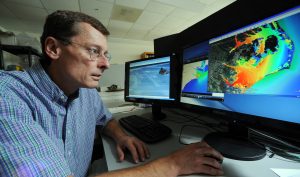Resilience is the capacity to recover after a disaster. As climate change threatens to increase hurricane frequency and strength, community resilience will be key for coastal communities.
When humans burn fossil fuels to produce energy, greenhouse gases — like carbon dioxide and methane — are released into the atmosphere. These gases trap energy from the sun and increase atmospheric temperatures. The ocean acts like a massive sink, absorbing more heat, increasing surface temperature, and melting land ice. This in turn contributes to sea level rise.
Warmer sea surface temperatures can also increase tropical storm wind speeds and precipitation amounts per storm. This translates to increased hurricane intensity and storm damage upon landfall. The predicted sea level rise as a result of climate change can also make hurricanes more damaging by amplifying coastal storm surge and increasing coastal flooding.
 Building Resilient Communities
Building Resilient Communities
As governments continue to rely on fossil fuels for the large majority of energy production, the planet is on track to warm between 3.5 to 8 degrees Celsius by the year 2100. This means hurricanes will begin to threaten the livelihoods of more people via damage to homes, infrastructure, and the economy.
Though reducing greenhouse gas emissions is the most direct way to address these new risks, coastal communities can also increase their resilience to the impacts of hurricanes in order to limit damage suffered.
Community resilience and post-hurricane recovery can be bolstered through:
- preserving and protecting coastal wetlands, dunes, and reefs to absorb storm surges;
- improving infrastructure such as seawalls;
- elevating vulnerable buildings to reduce flooding;
- designing new building structures to withstand high winds and flying debris; and
- preparing an evacuation plan.
 Improving Resilience in North Carolina
Improving Resilience in North Carolina
The UNC Institute of Marine Sciences in Morehead City provides a vital laboratory for studying hurricanes and resilience. UNC IMS Director Rick Luettich, who is also a lead principal investigator at the Coastal Resilience Center, led development of the ADCIRC Prediction SystemTM, which helps predict how hurricane storm surges will impact communities.
Throughout UNC IMS, labs examine hurricane impacts through a variety of lenses. While some examine how physical barriers like salt marshes may protect shorelines, others examine how storms impact critical coastal habitat, like dunes. Together, this work can better prepare our state for future hurricanes, which will likely increase in intensity as the climate warms.
But community resilience isn’t only about physical bolstering of coastal areas. It’s also about community needs and environmental justice.
Former Sustainable Carolina Council member Diamond Holloman began studying the socio-economic impact of hurricanes in Lumberton, NC after Hurricane Matthew made landfall in 2016. As a doctoral student in the Environment, Ecology and Energy (E3P) program, Holloman spent her time carrying out community-engaged research, talking to Lumberton residents about how hurricanes impacted their businesses, education, and overall well-being.
In 2019, Holloman received a Carolina Center for Public Service grant to study the impacts of Hurricane Florence in the same area. Holloman found that the effects of disasters like Hurricane Florence continue long after the flooding is over. The research carried out here will help local governments and organizations improve post-disaster outlook for all residents, no matter their background.
Understanding both science and the needs of communities will help our state’s coastal communities build a legacy of resilience.
Originally published December 6, 2021. Updated April 28, 2022.
